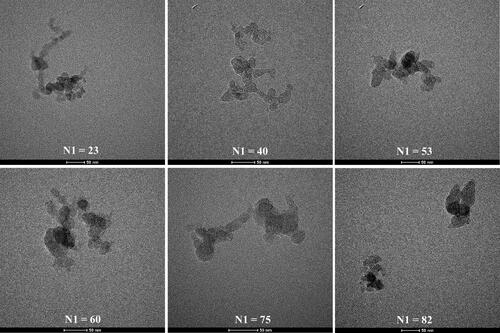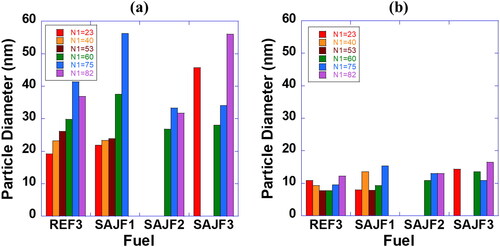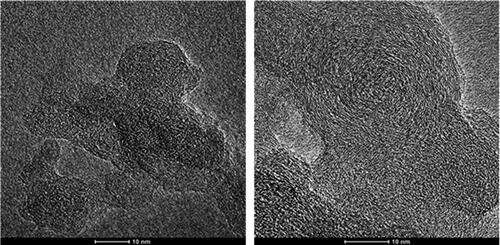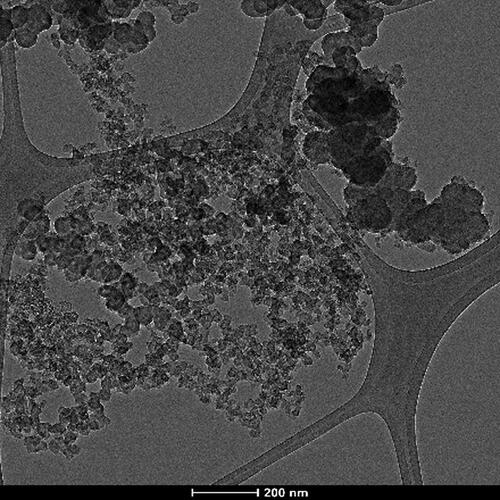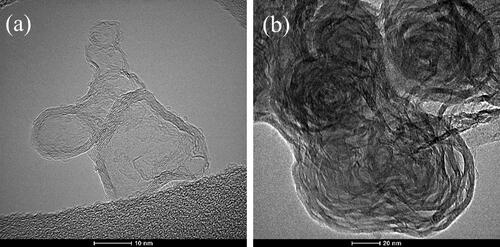 ?Mathematical formulae have been encoded as MathML and are displayed in this HTML version using MathJax in order to improve their display. Uncheck the box to turn MathJax off. This feature requires Javascript. Click on a formula to zoom.
?Mathematical formulae have been encoded as MathML and are displayed in this HTML version using MathJax in order to improve their display. Uncheck the box to turn MathJax off. This feature requires Javascript. Click on a formula to zoom.Abstract
Originating from an IAE V2527 aircraft gas turbine engine running a series of reference and blended fuels, nonvolatile particulate matter was collected upon transmission electron microscopy grids for analysis. A striking observation is the range of primary particle size with projected particle diameters ranging from 5 to 100 nm within the same aggregate. This range of particle size is interpreted as describing the corresponding ensemble of fuel rich pockets in terms of fuel-air-equivalence ratio (Φ) and duration. Some parcels are sufficiently diluted or short-lived by turbulent action and allow only small primary particles to form. Other parcels are larger, live longer or a combination allowing large primary particles to form. In this manner, the soot particles provide forensic insights into the turbulent mixing dynamics. Consequently, there is no single streamline or trajectory describing particle growth and no single condition in Φ or temperature for particle nucleation. There is also no observable correspondence between particle size and fuel aromatic or hydrogen content. Given the different trajectories of small/large particles, their growth histories and species origins, a difference in H/C ratio would be expected. This is reflected in the relative contributions of sp2/sp3 content within the particles as confirmed by electron energy loss spectroscopy analysis. Supporting evidence for the role of turbulent induced mixing upon primary particle growth is evidenced by varied particle size modes for XC-72, oxidation reactivity of R250, both commercial furnace blacks. Further confirmation is found by pulsed laser derivatization of XC-72.
Copyright © 2022 American Association for Aerosol Research
Graphical Abstract

EDITOR:
Introduction
Soot is formed as result of fuel pyrolysis or combustion under rich conditions. Soot aggregates consist of elementary spherical particles, referred to as primary particles. The primary particle size falls in the range of 1 − 10 nm and is affected by the residence time in the flame environment and by the fuel (De Falco et al. Citation2021). In realistic combustors based on the rich-quench-lean (RQL) concept, the mixture fraction distribution is very much dependent on the flow patterns, swirl number, strength and location of the dilution jets which can affect both soot production and soot oxidation (Cuoci et al. Citation2010).
In real devices, combustion occurs in the turbulent regime. Turbulence imposes chaotic changes to the equivalence ratio and lifetime of fuel rich parcels, hence the time average of the particle size distribution (PSD) at a given location can be very different from its instantaneous realization (Yunardi et al. Citation2018). This is not the case in laminar flows, where the flows are steady. While it is expected that the PSD in a turbulent flow flame differs from that observed in laminar flames (Lucchesi et al. Citation2017), actual knowledge of such distributions is limited, reflecting the challenge of performing detailed measurements in turbulent flames. Therein, measurements of the range in primary particle size provides forensic insight into the turbulence induced spread of primary size and indirectly, the spread of local equivalence ratio.
While our understanding of soot formation and growth have improved in recent years, the prediction of soot emissions remains a complex task. Soot formation involves a sequence of gas-phase reactions forming polycyclic aromatic hydrocarbons (PAH) followed by particle inception, particle–particle interactions, soot particle growth, and oxidation by heterogeneous reactions with chemical species in the gas-phase. The interactions between turbulent transport and molecular diffusion as well as local flow conditions (e.g., chemical species concentrations and temperature) play a key role in controlling soot concentrations (Attili et al. Citation2014; Bisetti et al. Citation2012). For example, Lucchesi et al. identified that variability in mixture fraction space was due to turbulent transport, affecting the time evolution of the naphthalene mass fraction experienced by soot (Cuoci et al. Citation2010). In fact, this was the motivation for Bisetti et al. to introduce methodology to capture the bimodality of the soot population size probability density function, which reflects the presence of small single particles as well as large aggregates (Bisetti, Blanquart, and Pitsch Citation2008). Presently, the capability to predict soot emissions in realistic combustion devices remains insufficient.
Thus far, numerous studies in laminar laboratory flames have served as surrogates and are comparison basis for numerical simulations and predictions (Wang Citation2011). Notably the trajectories most favored for measurement and modeling are those monotonic in temperature and mixture fraction. For example, the center streamline in laminar gas jet diffusion flames has been the keystone for soot formation/growth measurements and modeling. The uniform and monotonic conditions lead to primary particle inception and growth from the same species under the same conditions of Φ and temperature. As well noted by many studies in premixed and diffusion flames, all such primary particles are similarly sized and manifest nanostructure equivalency (Joo et al. Citation2018; Köylü et al. Citation1997). The initial gas parcel Φ, derived pyrolysis products and local nuclei particle concentration regulate the resulting aggregation mode and aggregate fractal dimension. To-date, there has been little sampling and particle analysis in laboratory turbulent non-premixed flames. Instead, knowledge has come from engines and combustors using real or surrogate fuels or their blends. From such devices, primary particle size and aggregates vary with load/thrust, fuel H-content, or fuel aromatic concentration.
Recent studies have reported the observation of very different average primary particle diameters in aggregates of different sizes (Olfert and Rogak Citation2019). Meanwhile aggregate simulations produce a “well-mixed” structure with aggregates possessing a wide range of primary particle sizes as opposed to being an assembly of uniformly sized spherules. A definitive study by Dastanpour and Rogak (Citation2014) analyzed thousands of aggregates and primary particles sampled from multiple operating conditions of three non-premixed and one (imperfectly) premixed combustion environments (aircraft jet engine, inverted diffusion flame, gasoline direct injection engine, heavy-duty compression ignition engine). They identified a correlation between primary particle and aggregate size; small primary particles comprising small aggregates and large primary particles comprising large aggregates, (refuting the results of cluster-aggregate simulations). We have reported similar primary particle and aggregate size correlations from a turbojet running Jet-A and varied biofuel blends with Jet-A (Kumal et al. Citation2020). Here, we report the observation of differently sized primary particles within the same aggregate.
The following report furnishes data as reference for model development of soot processes within a jet engine combustor and offers new insight into the interaction of turbulence and primary particle formation. The primary particle distribution is of fundamental importance for two reasons (Bisetti, Attili, and Pitsch Citation2014). First, the rates of surface processes such as growth and oxidation depend on the surface area, while the coagulation and aggregation rates depend on particle volume, and therefore, the distribution is an essential component of a detailed soot model. Second, prediction of the distribution is increasingly important on its own right, as new regulations are imposing limits on the concentrations of aggregates of different sizes, with increasing concern about the smaller particles, comprised of fewer and smaller primary soot particles.
Experimental methodology and characterization
Experimental setup and data collection
In a NASA/DLR collaboration, the field campaign NASA/DLR Multidisciplinary Airborne Experiment – Emission and Climate Impact of Alternative Fuel (NDMAX/ECLIF) was conducted between 14 January and 3 February 2018, from Ramstein Air Base in southwest Germany. Ground-based particle and gas measurements were performed on the DLR A320 “Advanced Technology Research Aircraft (ATRA)” with IAE V2527 aircraft engines as the emissions source (Schripp et al. Citation2022). The IAE is a high bypass ratio turbofan engine featuring a single stage fan, 4-stage Low Pressure Compressor (LPC), 10-stage High Pressure Compressor (HPC) and annular combustion chamber. Tests were conducted as a function of thrust.
Research objectives for the campaign included, (1) examining the effects of alternative fuels and engine technology on aircraft emission and contrails, (2) collecting aerosol and trace gas data for validating models and satellite-sensor measurements, and (3) evaluating the performance of new instruments and inlets for potential use in future earth-science missions. The experimental plan was to investigate BC optical properties, morphology, EC-OC fraction as a function of fuel composition and compare number and mass-based emissions measured with a wide array of instruments.
For results presented here, exhaust particles were collected onto amorphous-carbon films on copper support grids (Ted Pella Inc., Redding, CA, USA) using an electrostatic precipitator, an ESPnano (Model 100) for microscopy analysis. nvPM was sampled without benefit or complication of sampling line, dilution factor(s), line losses and associated corrections. Samples were taken in the free jet plume roughly 50 m behind the engine. Particle size selective deposition (loss) is mitigated. In trade, this ambient sampling does not lend itself to quantitative mass measurements, particularly as thrust is varied. Collected is an unfiltered, ambient particulate sample. Repeat samples on different days and times by qualitative inspection for coverage and range of aggregate size and morphology for these replicate samples did not reveal discernable differences – suggesting the ambient conditions did not interfere or significantly bias sample collection. Other measurements were made using a heated sampling line and distribution manifold to separate stations as reported elsewhere (Corbin et al. Citation2022). Further details regarding the campaign, objectives and experiments may also be found therein.
gives the relation between thrust and power. A series of reference and blended fuels were studied to vary aromatic concentration, H/C ratio and smoke point. Results presented here are results from transmission electron microscopy (TEM) analysis of nonvolatile particulate matter (nvPM). Collected directly upon TEM film grids, aggregate, primary particle, and nanostructure scales were analyzed for selected conditions.
Table 1. Thrust and power relationship.
summarizes fuel properties. Aromatics are well known precursors to soot, necessary for particle inception and often contributing to mass growth by radical addition-propagation reactions. For the biofuel blend SAJF1 the aromatic content is approximately ½ that of the reference (REF3) fuel while SAJF2 has slightly higher aromatic content. On this basis the two synthetic blends are considered similar for comparison to the REF3 fuel. Hydrogen contents are also listed.
Table 2. Fuel properties.
Characterization
TEM is performed on an FEI Talos F200X equipped with a 200 keV FEG source providing a resolution of 0.12 Å. Electron energy loss spectroscopy (EELS) measurements were taken using FEI Titan G2 microscope operated at 300 kV in STEM mode for high spatial resolution. The instrument is equipped with a Gatan GIF Quantum electron filter and the monochromator provides an energy resolution close to 0.1 eV with the monochromator activated. A Shirley background was subtracted in the 284 − 305 eV region and a Gaussian peak was fitted in each transition range. The peak intensity and full width at half max (FWHM) were allowed to vary and the fit with the lowest residual value was selected for quantification. The sp2 and sp3 contents were estimated using integrated area under the two transition peaks.
Laser annealing
Commercially available XC-72 carbon black was laser heated using 1 pulse of 170 mJ/cm2 of the Nd:YAG laser, operating at a wavelength of 1064 nm. Pulse duration is fixed at 8 ns. Thus, sample heats up rapidly in <8 ns to temperatures >3000 °C in an inert, and cools to atmospheric temperature over the next few microseconds after the laser pulse.
Results
Observations
TEM images
Aggregates of varied size, geometry were observed. Not only did the primary particle size vary between aggregates but also within aggregates. While most aggregates consisted of similarly sized primary particles forming the aggregate backbone, there were often substantially smaller primary particles attached to the larger primaries, typically at outer edges of the aggregate. and show a survey of images for the REF3 and SAJF1 fuels across thrust levels, respectively. For any given fuel dozens of images were collected. While only a single image is shown, no inference should be made regarding aggregate scale or morphology as specific to the fuel or power. In fact, the range of aggregates across thrust can be taken as illustrative of that observed for any particular thrust level. Images were selected to best illustrate primary particle size variation within a given aggregate. Similar aggregate size, morphology and primary size variations were observed for other fuels and thrust levels for which data was available. As an illustration, shows TEM images for the SAFJ2 and SAJF3 fuels.
Figure 2. TEM images across thrust levels (N1) thrust levels for the SAJF1 fuel (scale bar is 50 nm).
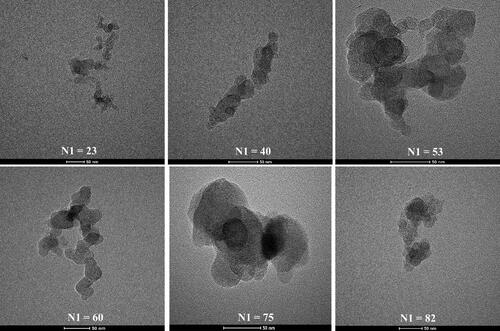
Figure 3. TEM images for the SAJF2 (scale bar is 50 nm) and SAJF3 (scale bar is 100 nm) fuels at the indicated N1 values.
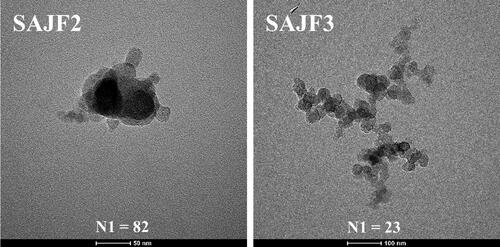
Primary particles are identified as the individual spherules while their composite assemblage is the aggregate. Note that primary particles are highly varied in size although existing within the same aggregate. Detailed examination of the perimeter of the small particles revealed no evidence of oxidation such as protruding lamellae, due to liberation from cross links or fullerenic structures.
For any given engine thrust, aggregate size and morphology vary widely. The projected particle size range is 5 − 50 nm and corresponding volumes then span 65 − 8180 nm3 while external (geometric) surface areas then vary between 79 and 1960 nm2. In other words, a ratio of 50 in diameter geometrically translates into a vast range in area and mass for individual primary particles.
These values make no reference to a particular distribution across this size range. Primary particle size distributions appear to follow a log-normal distribution as illustrated by the histogram in for which several hundred particles were analyzed for the REF3 fuel at an N1 = 75 condition. (Similar results were observed for other thrusts, and fuels (e.g., SAJF1, N1 − 75). With limited data for some fuels and thrusts, other distributions appear similarly broad but a flat distribution or broad log-normal (rather than highly peaked) cannot be precluded.
Analysis method
For a broad asymmetric distribution with extended tail, the median is a better measure of central tendency, but it is rather insensitive to the distribution range. Our focus on the primary particle size distribution range is motivated by the interaction of turbulence and Φ where turbulent-driven fuel-air mixing determines the range of Φ across fuel rich pockets. In turn, the distribution in Φ determines the range of primary particle size. To better understand these coupled factors, we focus on the lowest and highest percentiles for each distribution.
For any given fuel several hundred primary particles were measured. From a ranked order based on size, the mean values of the 5th and 95th percentiles were calculated. They were used to examine effects of thrust and fuel composition upon Φ, as inferred from primary particle size.
Conceptualization of fuel-rich pockets
“Φ-equivalent” is defined here as a combination of Φ and spatial extent of the fuel rich pocket. Higher Φ corresponds to a fuel-rich pocket that has experienced less mixing by turbulence. By contrast, a low Φ (yet above a soot formation threshold) corresponds to high fuel-air mixing where the fuel concentration is substantially diluted. In other words, the fuel-rich region is nearly “mixed out.” The degree of mixing likely affects the size of the fuel-rich pocket wherein high Φ regions are large in spatial extent compared to regions of low Φ. Hence “Φ” is understood to include an implicit “size” dependence. To the extent that a fuel-rich pocket can “tolerate” a greater level of turbulent mixing before becoming sufficiently diluted and unable to sustain particle growth, its lifetime would presumably be longer in duration relative to that of a fuel-rich pocket with lower Φ.
Particle size dependence on thrust
The bar-graph charts in show the mean values for the 95th and 5th percentiles for the different thrust levels across the varied fuels. The group of bars for each fuel represent the mean particle sizes for those thrust levels where samples had been collected.
With increasing thrust, both fuel flow and combustor temperature increases, and thus, for the REF3 and SAJF1 fuels, we observe a near monotonic progression with increasing thrust. Each factor would contribute to larger particle sizes by higher Φ and faster particle inception and growth in a fuel-rich (albeit transient) pocket.
Oppositely, higher turbulence might be expected to shorten the duration of particle growth wherein fuel-rich pockets are rapidly “mixed out” (after being created). The increasing large particle size (95th percentile mean) with increasing thrust reflect the net of these competing factors. Hence, increasing large particle size corresponds to increasing size range with increasing thrust across fuels.
Meanwhile the small particle sizes (means of the 5th percentile) are largely invariant with respect to thrust level. Moreover, regardless of thrust level, the smallest particle size remains relatively invariant across fuels. Based on the conceptual model, this particle size reflects the minimum Φ required to sustain particle inception and growth. Smaller Φ values are insufficient for particle growth, the reason being that a low Φ corresponds to a small spatial domain and likely shorter lifetime. The invariant small particle size suggests that for any given thrust (turbulence level) and fuel composition, the turbulence is capable of fully “mixing out” fuel-rich pockets below a minimum threshold required for particle inception and growth. With this perspective, the range of soot particle size as a surrogate for the range of Φ corresponds to only a portion of the full range of Φ where many lean Φ regions are likely to exist, but do not form particles. For this reason, the primary particles provide a snapshot for the range of Φ where fuel-air mixing is incomplete.
While for some selected conditions statistics were (barely) suitable for determination of primary particle size distribution, it appeared to be log-normal. But distributions for other conditions could be flat or otherwise skewed. Consequently, to not make reference to any pre-defined distribution (i.e., no pre-selected mathematical functional form), percentiles were chosen to represent the primary particle size distribution. Notably even if the distributions were log-normally distributed for all conditions of power/fuel, the average is a poor measure of central tendency as it is heavily dependent upon the distribution tail. While the median is better, the standard deviation relies upon pre-specified mathematical model (distribution) and beyond the standard normal distribution, is not intuitive and in all cases is simply one of two parameters of a mathematical (model/distribution) fit to the data spread. Moreover, such a comparison would presume that the distributions were invariant in form across all conditions of fuel and thrust. In fact, that the upper percentile changes substantially while the lower percentile does not – clearly shows that the distribution skewness (and kurtosis) are both changing – and that the distributions are not invariant. Therein measures of average and standard deviation are not meaningful.
Focusing on the high (95th) percentile and its shift with changing fuel/thrust highlights the expanding range of primary particle size and tradeoffs between higher Φ (associated with higher thrust), higher temperature and offsetting higher turbulence decreasing particle growth duration. Such demarcation would be lost by an average and standard deviation. Samples as provided from the campaign did not permit development of sufficient statistics to obtain valid samplings of the primary size distributions. Correspondingly, focusing on the low percentile and its lack of shift with changing fuel/thrust highlights that the threshold of primary particle formation and lowest associated Φ able to sustain particle formation, albeit with minimal growth is invariant with respect to fuel and thrust level.
We did observe a morphological dependence consistent with our interpretation of primary particle size origin. Specifically compact aggregates were associated with a wide primary particle size range. Forming under high Φ, interior primary particles grow large and for their high number density under fuel-rich conditions, undergo ballistic clustering to form a compact aggregate. With high Φ, the fuel-rich pocket exists for a longer duration before turbulence reduces Φ below a critical value, allowing yet small primary particles to form under conditions of turbulence diluted Φ and decorate the exterior of the aggregates. Meanwhile highly branched, dendritic clusters form with smaller particles, rather uniform in size (not exhibiting a large range). Formed under conditions of reduced Φ, particles are smaller and under these conditions are formed with a lower number density – leading then to different clustering dynamics – reactive clustering and branched aggregate morphologies.
To note, this is not an interpretation of the number of such fuel-rich pockets or total (extrinsic) soot emission. Instead, it is an intrinsic view of soot formation within the jet combustor focused on primary particle size as metric. There is no reference to the number of fuel rich pockets nor their distribution in “Φ” but only their range in Φ as evidenced by primary particle size.
Particle size dependence on fuel composition
shows the difference between the largest and smallest (95th and 5th) percentile means for the different thrust levels grouped by fuel hydrogen and aromatic content. With small particle size being somewhat constant, changes in range largely reflect changes in the largest particle, 95th percentile mean size. Each fuel corresponds to a given hydrogen content. As discussed previously, across thrust levels for a given fuel, the range of primary particle size increases. However, comparison across fuels for any given thrust level (bars with same color) reveals no discernable trend. To be clear, this is not a statement regarding emission mass or black carbon emission index (EIbc) but is an intrinsic measure of the range of Φ. No observable trend suggests that the soot particle size (or Φ-equivalent) is decoupled from fuel aromatic or hydrogen content. As measurements of emission mass have shown such dependencies for which semi-empirical relations have been developed (Abrahamson et al. Citation2016; Choo Citation2019; Kathrotia and Riedel Citation2020; Speth et al. Citation2015; Teoh et al. Citation2017), one might speculate that fuel composition translates into the number of fuel-rich pockets.
Figure 6. Difference between largest and smallest mean particle diameter vs. (a) hydrogen and (b) aromatic content.
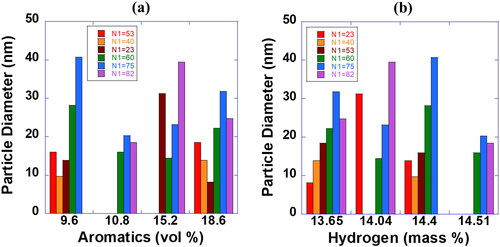
Alternatively, an increase in relative size would also increase overall mass by enabling a greater number of particles. Here, from a microscopic perspective, neither fuel metric affects particle size. While nucleation could be accelerated by fuel aromatic (or hydrogen deficient) fuel precursors, allowing then longer growth duration and correspondingly larger size, this does not appear to occur, based on observations reported here.
Fuel aromatics and hydrogen content are known to impact the emission mass and particle number (Abrahamson et al. Citation2016; Brem et al. Citation2015; Choo Citation2019; Kathrotia and Riedel Citation2020; Moore et al. Citation2015; Schripp et al. Citation2018; Speth et al. Citation2015; Teoh et al. Citation2017). Both emission metrics seemingly reflect the ability of these critical fuel factors to govern the number of fuel-rich, soot forming pockets but not the growth of primary particles. If the distribution of fuel rich regions once formed were maintained, then fuel compositional effects would be expected to exert control upon particle size. However, the distribution of fuel rich pockets is not static but rather a transitory snapshot before the same pockets are mixed out by turbulence. Hence, the duration for growth and fuel compositional effects to become evident with particle size may be too short.
In general, nonvolatile carbonaceous particulate from a gas turbine is smaller than that from a diesel engine, partially indicative of different residence times and turbulence levels, providing qualitative support for their impact (Vander Wal, Bryg, and Hays Citation2010). So even though the number (and/or size) of fuel-rich pockets capable of forming particulate may increase with aromatic content or lower H-content, turbulence may limit the maximum Φ-equivalent. While the data may suggest some particle size dependence upon these factors, current data is too sparse for definitive determination.
EELS analysis
EELS is used to illustrate particle-to-particle variation (or lack thereof) of sp2 to sp3 hybridized carbon. The integrated EELS intensities are the basis for differentiating sp2 and sp3 orbitals, based on the corresponding electronic transition intensities and associated energy loss of the incident electrons (Alexandrou et al. Citation1999; Cuomo et al. Citation1991; Daniels et al. Citation2007). Given the different trajectories, growth histories and species origins of small versus large particles, a difference in sp2/sp3 content would be expected. Between the small versus the large particle size classes percentiles the sp2/sp3 ratio increases by a factor of 30.5. This difference highlights their different composition and formation origins. It also suggests that the fuel pyrolysis chemistry is different in the respective fuel rich pockets. This is consistent with the different Φ arising from varied levels of partial premixing.
HRTEM imaging and analysis
HRTEM images reveal differences in nanostructure between small versus large primary particles, as seen in . The tenet is smaller primary particles reflect formation in lower Φ environments, produced by turbulence. Therein lower Φ reflects a higher degree of partial premixing. Varied levels of partial premixing are manifested by differences in lamellae curvature as we have reported previously (Huang and Vander Wal Citation2016; Kumal et al. Citation2020). Curved lamellae are evident in the small particles, but largely absent in the larger particles which exhibited a core-shell structure. As aggregates were collected upon TEM grids with a carbon film, fringe analysis of small particles and comparison to large particles was not possible. And, given the limited data for such a comparison, an alternative method, laser derivatization was applied.
Discussion
What accounts for variation in primary particle size within the same aggregate? Unlike laboratory flames, primary particle sizes in aggregates vary substantially: radially by 10x and volumetrically by 1000x. Such a range is consistent with the postulated spread in Φ and duration for growth therein. We posit that some large fuel rich parcels mix out slowly, allowing for extended growth of primary particles. The high Φ also fosters high primary number density, leading to compact aggregates. As fuel dilution occurs Φ yet allows some primary particles to form. Their delayed inception under a lower Φ allows less time for growth – as reflected by their smaller size. As Φ is lower, fewer small particles are able to form. Notably these particles decorate the periphery of the forming aggregates and motivate our focus on smallest and largest percentiles as being most sensitive to, and hence, best measure of this “particle formation window.”
To consider the possibility of oxidation, how would this occur? Oxidation of only selected primary particles within the aggregate is illogical, given their proximity. It is, however, possible that some primary particles oxidized prior to coalescence with others that had not undergone any oxidation. This would, in principle, account for their vast size range, with the larger particles essentially being untouched by oxidation and instead emerging fresh from growth. Yet small particles do not exhibit visible signs of oxidation such as roughened outer surfaces, tightly curled surface lamellae, pores, or evidence of interior burning (Gaddam et al. Citation2016). Moreover, small and large particles exhibit “necking” due to growth following aggregation requiring exposure to a fuel rich environment. This observation further supports particle size as being nascent wherein particles emerging at different time yet from the same fuel rich parcel aggregate. The alternative scenario would be selective oxidation occurring prior to aggregation and subsequent re-introduction into a fuel rich environment for further mass deposition resulting in the observed “necks” between small and large particles. This scenario is without observable precedence to the authors’ knowledge. Although this is not definitive, it is also unlikely that particles emerging from extensive oxidation would subsequently coalesce into an aggregate rather than remaining separate and continue to oxidize.
Based on analysis of hundreds of TEM images from three non-premixed and one (imperfectly) premixed combustion systems, Dastanpour and Rogak found a correlation between primary particle and aggregate size (Dastanpour and Rogak Citation2014). It was shown that larger aggregates are mainly composed of larger primary particles. Moreover, the primary particles are more uniform in individual aggregates than in ensembles of aggregates. We have reported similar correlations from a turbojet running Jet-A and varied biofuel blends with Jet-A (Kumal et al. Citation2020). This is an important distinction from the present article which finds (some) evidence supporting the “well-mixed” result of simulations (although this was not the aim of our study!) Thus, the results of the present study somewhat derate the correlation between primary particles and aggregate size; some heterogeneity of primary particle size can occur within the same aggregate.
Recently Baldelli et al. have reported differently sized (groups) of primary particles within aggregates (Baldelli et al. Citation2020). The “groups” appear as separate aggregates given their extensive size, branched morphology and similarly sized primary particles comprising it. Yet cluster-cluster aggregation is refuted as causative, and that sampling deposition was sufficiently low such that these appendages should not be interpreted as overlapping aggregates. In other samples, super-sized primary particles with size ranging from 190 to 350 nm appear. The occur individually or in a cluster of 2–5, appear “stuck” or otherwise deposited on aggregates if in contact with them, and are attributed to enhanced nucleation.
An important point arises for interpreting the origin of the small size class of primary particles within an aggregate. Do they form subsequent to the large particles, yet within the same fuel rich pocket but under low Φ due to turbulence action intervening between large/small particle formation/growth? Could such particles form concurrently? If such particles were to form rather concurrently the Φ be relatively constant and only similarly sized primary particles would result. Such differently sized particles could form concurrently while yet within the same fuel rich pocket if there were steep gradients in Φ. For example, the central region with high Φ could promote the formation of large primary particles while smaller primary particles form in outer regions with lower Φ. Thus, turbulence need not be invoked to rationalize an overall dilution of a fuel rich pocket versus creating steep gradients in Φ. The present study does not resolve these possibilities but does offer relative timescales (concurrent or sequential primary particle formation) which CFD modeling could resolve.
Similarities with XC-72
Supporting the tenet of primary particle formation within different environments are related observations on XC-72, a commercial carbon black. The high turbulence levels within the reactor lead to a wide range of particle growth trajectories through Φ and temperature, resulting in a wide range of primary particle size as observed in . The primary particle size distribution subdivides into three distinct modes, with the mean of each listed in . Although operated with an overall fuel-rich Φ compared to a fuel lean Φ as for the jet engine, the concept of different fuel-rich parcels and varied trajectories in Φ and temperature yet pertains. The primary particle size reflects the integration of the surface mass addition rate over its own particular trajectory in time and Φ with implicit dependence upon the species identity and concentration. Subsequent aggregation of these primaries accounts for the range of sizes within a given aggregate.
Table 3. Summary of mean particle sizes for XC-72.
Pulsed laser derivatization
If primary particles are formed in different environments – the differences in growth species and temperature should be manifested in the chemistry and nanostructure. Indeed, our prior studies of nvPM from jet engines using alternative fuels and their blends with JP-8 (Huang and Vander Wal Citation2013), soot from diesel engines using biodiesel and blends with Ultra low sulfur diesel (ULSD) showed such dependencies with support from chemical kinetic calculations and one-dimensional spray models (Vander Wal et al. Citation2013). Nanostructure should reflect aromatic versus acetylene as growth species and Φ by curvature dependence upon C5, but small differences are difficult to gauge while the TEM grid film makes high resolution imaging, necessary for fringe analysis difficult. Moreover, small differences such as cross links, slit pores and misalignments are not well differentiated by microscopic imaging or spectroscopic measurements.
Recently we have demonstrated a new technique – laser derivatization by which the fast annealing imposed by a high intensity laser pulse accentuates small differences in nanostructure – effectively derivatizing the solid-state structure yielding restructured lamellae with distinctly different and recognizable spatial patterns (Singh and Vander Wal Citation2020; Singh et al. Citation2019), thereby easing quantification. Pulsed laser heating was attempted with the jet samples as provided upon carbon film TEM grids. The film was sufficiently absorptive of the laser light as to interfere with subsequent particle identification. Hence, our focus shifted to XC-72. To illustrate the different compositions between small and large XC-72 primary particles we applied laser derivatization. As the HRTEM images in show, lamellae in large particles develop a distinct banded structure, with the multiple concentric bands nested about the particle center. In contrast, the small particles develop a hollow shell with extended lamellae forming an outer shell. These distinctly different behaviors have been observed before and related to formation origins differing in Φ (Singh and Vander Wal Citation2020; Singh et al. Citation2019).
Implications
Modeling of soot formation in combustion processes requires coupling aerosol dynamics with fluid dynamics (Rigopoulos Citation2019). The presence of turbulence poses an additional challenge, due to the nonlinear interactions between fluctuating velocity, temperature, concentrations, and soot properties. While models for turbulence-chemistry interaction have undergone considerable development, by contrast, the interaction of turbulence and soot is yet at early stages of investigation.
Primary particle size is important to modeling. The rates of surface processes such as growth and oxidation depend on the surface area, while the coagulation and aggregation rates depend on particle volume, and therefore, the distribution is an essential component of a detailed soot model. Moreover, prediction of the distribution is increasingly important on its own right, as new regulations are imposing limits on the concentrations of particles of different sizes, with increasing concern about the smaller particles.
The range of primary particles sizes reflects the effectiveness of turbulence in creating the ensemble of fuel rich pockets and subsequent aggregation of particles from these pockets over the time permitted by turbulence – before they are “mixed out.” A similar broad range of primary particle size within most aggregates was observed across fuels. Notably this is different than simply a range of sizes wherein any aggregate is comprised of similarly sized particles. We hypothesize that primary particles formed across a diverse range of Φ and temperature conditions (as the fuel-rich parcel evolves) leads to their broad range of final sizes within the aggregate. Consequentially, there is no single streamline or trajectory, nor a single condition in Φ or temperature describing particle growth given the varied staging of inception and growth within an evolving fuel-rich parcel. Since soot kinetics depend on the concentration of precursors, accurate modeling of both chemistry and turbulence–chemistry interaction are prerequisites for the successful prediction of soot in a turbulent flow.
The traditional approach to predicting soot emissions from gas turbine engines is to use one of many empirical correlation formulas that have been developed relating soot emission to bulk fuel composition and/or the laminar smoke point of the particular fuel. These correlations have been based on fuel hydrogen content, H/C ratio, aromatic content, and naphthalene content, among other variables (Abrahamson et al. Citation2016; Brem et al. Citation2015; Choo Citation2019; Kathrotia and Riedel Citation2020; Moore et al. Citation2015; Schripp et al. Citation2018; Speth et al. Citation2015; Teoh et al. Citation2017). Indeed our prior work developed a power law relation between EIbc and thrust for a RQL style combustor, accounting for fuel compositional differences by an exponential factor in H/C ratio based on the Formation-Oxidation (FOX) approach (Abrahamson et al. Citation2016). Importantly, these relations address overall emissions by hydrogen (mass) content. In contrast, the proposed construct here addresses primary particle inception and size. However, soot emissions vary considerably with combustor operating conditions (i.e. idle, cruise, and takeoff settings), as would be expected with the resultant variations in combustor inlet temperature and pressure (Abrahamson et al. Citation2016; Choo Citation2019; Teoh et al. Citation2017). Empirical approaches are challenged while modeling approaches require benchmarks for comparison as presented here.
Results from laboratory flame studies stand in stark contrast to these observations. An abundance of soot formation, growth studies in gas jet diffusion flames have shown that within aggregates, primary particles are similarly sized, having traversed the same trajectory in temperature and (monotonically decreasing) Φ (Santoro and Miller Citation1987). Indeed, such uniformity has aided development of soot growth models (Dworkin et al. Citation2011; Xuan and Blanquart Citation2016).
Conclusions
The present study differs from prior studies identifying a correlation between primary particle size and aggregate size wherein smaller primary soot particles formed smaller aggregates while larger primary particles formed larger aggregates. The underlying causative factor is the fuel-air equivalence ratio of the fuel-rich pocket governing both primary particle inception, i.e., number density affecting aggregate size and individual spherule growth rate. Therein aggregates are comprised of similarly sized primary particles. In the present study differently sized primary particles are found within the same aggregate. Results are interpreted as modification to Φ as the governing factor by suggesting steep gradients in Φ, induced by turbulence may give rise to the very different primary sizes that yet assemble into the same aggregate. Still, as reported previously, turbulence also accounts for the distribution of Φ, affecting both primary and aggregate size.
Restating observations, there is no single primary particle size, aggregate size, morphology. More importantly there is no single trajectory in which particles form, grow, and aggregate. The local Φ in fuel rich pockets is a result of partial premixing and varies with time. High thrust intensifies turbulence and creates a wide range of (local) turbulence levels. In a concerted fashion turbulence creates the broad spread in Φ and further regulates particle growth by duration and Φ of these particle-forming parcels. Particle growth tracks with Φ, namely the lowest Φ (and highest turbulence level) forms the smallest particles while the richest Φ (and least turbulence level) forms the largest particles. Alternately stated, the lowest Φ results from the highest turbulence level while the richest Φ results from the least turbulence level. Turbulence also regulates time over which Φ (of the fuel rich pocket) is above the threshold for particle formation/growth. EELS analysis reveals different sp2/sp3 ratios for small versus large primary particles, consistent with their different formation (Φ) environments. Overall, the different primary particle modes for XC-72, laser derivatization for R250 (supporting different formation conditions) and associated reactivity differences further illustrate the impact of turbulence and partial mixing upon soot particle growth.
Additional information
Funding
References
- Abrahamson, J. P., J. Zelina, M. G. Andac, and R. L. Vander Wal. 2016. Predictive model development for aviation black carbon mass emissions from alternative and conventional fuels at ground and cruise. Environ. Sci. Technol. 50 (21):12048–55. doi:10.1021/acs.est.6b03749.
- Alexandrou, I., J. Scheibe, C. J. Kiely, A. J. Papworth, G. A. J. Amaratunga, and B. Schultrich. 1999. Carbon films with a novel sp 2 network. Phys. Rev. B 60 (15):1–15.
- Attili, A., F. Bisetti, M. E. Mueller, and H. Pitsch. 2014. Formation, growth, and transport of soot in a three-dimensional turbulent non-premixed jet flame. Combust. Flame 161 (7):1849–65. doi:10.1016/j.combustflame.2014.01.008.
- Baldelli, A., U. Trivanovic, J. C. Corbin, P. Lobo, S. Gagné, J. W. Miller, P. Kirchen, and S. Rogak. 2020. Typical and atypical morphology of non-volatile particles from a diesel and natural gas marine engine. Aerosol Air Qual. Res. 20 (4):730–40. doi:10.4209/aaqr.2020.01.0006.
- Bisetti, F., A. Attili, and H. Pitsch. 2014. Advancing predictive models for particulate formation in turbulent flames via massively parallel direct numerical simulations. Phil. Trans. R Soc. A 372 (2022):20130324. doi:10.1098/rsta.2013.0324.
- Bisetti, F., G. Blanquart, M. E. Mueller, and H. Pitsch. 2012. On the formation and early evolution of soot in turbulent nonpremixed flames. Combust. Flame 159 (1):317–35. doi:10.1016/j.combustflame.2011.05.021.
- Bisetti, F., G. Blanquart, and H. Pitsch. 2008. Direct numerical simulation of soot formation in turbulent non-premixed flames. Annu. Res. Brief, Stanford Univ. USA. Cent. Turbul. Res. 21:1–13.
- Brem, B. T., L. Durdina, F. Siegerist, P. Beyerle, K. Bruderer, T. Rindlisbacher, S. Rocci-Denis, M. G. Andac, J. Zelina, O. Penanhoat, et al. 2015. Effects of fuel aromatic content on nonvolatile particulate emissions of an in-production aircraft gas turbine. Environ. Sci. Technol. 49 (22):13149–57. doi:10.1021/acs.est.5b04167.
- Choo, K. H. 2019. A methodology for the prediction of non-volatile particulate matter from aircraft gas turbine engine. Georgia Tech Theses and Dissertations.
- Corbin, J. C., T. Schripp, B. E. Anderson, G. J. Smallwood, P. LeClercq, E. C. Crosbie, S. Achterberg, P. D. Whitefield, R. C. Miake-Lye, Z. Yu, et al. 2022. Aircraft-engine particulate matter emissions from conventional and sustainable aviation fuel combustion: Comparison of measurement techniques for mass, number, and size. Atmos. Meas. Tech. 15 (10):3223–47. doi:10.5194/amt-15-3223-2022.
- Cuoci, A., A. Frassoldati, D. Patriarca, T. Faravelli, E. Ranzi, and H. Bockhorn. 2010. Soot formation in turbulent non premixed flames. Chem. Eng. Trans. 22:35–40. doi:10.3303/CET1022005.
- Cuomo, J. J., J. P. Doyle, J. Bruley, and J. C. Liu. 1991. Sputter deposition of dense diamond-like carbon films at low temperature. Appl. Phys. Lett. 58 (5):466–8. doi:10.1063/1.104609.
- Daniels, H., R. Brydson, B. Rand, and A. Brown. 2007. Investigating carbonization and graphitization using electron energy loss spectroscopy (EELS) in the transmission electron microscope (TEM). Philos. Mag. 87 (27):4073–92. doi:10.1080/14786430701394041.
- Dastanpour, R., and S. N. Rogak. 2014. Observations of a correlation between primary particle and aggregate size for soot particles. Aerosol Sci. Technol. 48 (10):1043–9. doi:10.1080/02786826.2014.955565.
- De Falco, G., I. E. Helou, P. M. de Oliveira, M. Sirignano, R. Yuan, A. D'Anna, and E. Mastorakos. 2021. Soot particle size distribution measurements in a turbulent ethylene swirl flame. Proc. Combust. Inst. 38 (2):2691–9. doi:10.1016/j.proci.2020.06.212.
- Dworkin, S. B., Q. Zhang, M. J. Thomson, N. A. Slavinskaya, and U. Riedel. 2011. Application of an enhanced PAH growth model to soot formation in a laminar coflow ethylene/air diffusion flame. Combust. Flame 158 (9):1682–95. doi:10.1016/j.combustflame.2011.01.013.
- Gaddam, C. K., R. L. Vander Wal, X. Chen, A. Yezerets, and K. Kamasamudram. 2016. Reconciliation of carbon oxidation rates and activation energies based on changing nanostructure. Carbon N. Y 98:545–56. doi:10.1016/j.carbon.2015.11.035.
- Huang, C.-H., and R. L. Vander Wal. 2013. Effect of soot structure evolution from commercial jet engine burning petroleum based JP-8 and synthetic HRJ and FT fuels. Energy Fuels 27 (8):4946–58. doi:10.1021/ef400576c.
- Huang, C.-H., and R. L. Vander Wal. 2016. Partial premixing effects upon soot nanostructure. Combust. Flame 168:403–8. doi:10.1016/j.combustflame.2016.01.006.
- Joo, P. H., B. Gigone, E. A. Griffin, M. Christensen, and Ö. L. Gülder. 2018. Soot primary particle size dependence on combustion pressure in laminar ethylene diffusion flames. Fuel 220:464–70. doi:10.1016/j.fuel.2018.02.025.
- Kathrotia, T., and U. Riedel. 2020. Predicting the soot emission tendency of real fuels–A relative assessment based on an empirical formula. Fuel 261:116482. doi:10.1016/j.fuel.2019.116482.
- Köylü, Ü. Ö., C. S. McEnally, D. E. Rosner, and L. D. Pfefferle. 1997. Simultaneous measurements of soot volume fraction and particle size/microstructure in flames using a thermophoretic sampling technique. Combust. Flame 110 (4):494–507. doi:10.1016/S0010-2180(97)00089-8.
- Kumal, R. R., J. Liu, A. Gharpure, R. L. Vander Wal, J. S. Kinsey, B. Giannelli, J. Stevens, C. Leggett, R. Howard, M. Forde, et al. 2020. Impact of biofuel blends on black carbon emissions from a gas turbine engine. Energy Fuels 34 (4):4958–66. doi:10.1021/acs.energyfuels.0c00094.
- Lucchesi, M., A. Abdelgadir, A. Attili, and F. Bisetti. 2017. Simulation and analysis of the soot particle size distribution in a turbulent nonpremixed flame. Combust. Flame 178:35–45. doi:10.1016/j.combustflame.2017.01.002.
- Moore, R. H., M. Shook, A. Beyersdorf, C. Corr, S. Herndon, W. B. Knighton, R. Miake-Lye, K. L. Thornhill, E. L. Winstead, Z. Yu, et al. 2015. Influence of jet fuel composition on aircraft engine emissions: A synthesis of aerosol emissions data from the NASA APEX, AAFEX, and ACCESS missions. Energy Fuels 29 (4):2591–600. doi:10.1021/ef502618w.
- Olfert, J., and S. Rogak. 2019. Universal relations between soot effective density and primary particle size for common combustion sources. Aerosol Sci. Technol. 53 (5):485–92. doi:10.1080/02786826.2019.1577949.
- Rigopoulos, S. 2019. Modelling of soot aerosol dynamics in turbulent flow. Flow. Turbulence Combust. 103 (3):565–604. doi:10.1007/s10494-019-00054-8.
- Santoro, R. J., and J. H. Miller. 1987. Soot particle formation in laminar diffusion flames. Langmuir 3 (2):244–54. doi:10.1021/la00074a018.
- Schripp, T.,B. E. Anderson,U. Bauder,B. Rauch,J. C. Corbin,G. J. Smallwood,P. Lobo,E. C. Crosbie,M. A. Shook,R. C. Miake-Lye, et al. 2022. Aircraft engine particulate matter emissions from sustainable aviation fuels: Results from ground-based measurements during the NASA/DLR campaign ECLIF2/ND-MAX. Fuel 325:124764.doi:10.1016/j.fuel.2022.124764.
- Schripp, T., B. Anderson, E. C. Crosbie, R. H. Moore, F. Herrmann, P. Oßwald, C. Wahl, M. Kapernaum, M. Köhler, P. Le Clercq, et al. 2018. Impact of alternative jet fuels on engine exhaust composition during the 2015 ECLIF ground-based measurements campaign. Environ. Sci. Technol. 52 (8):4969–78.
- Singh, M., C. K. Gaddam, J. P. Abrahamson, and R. L. Vander Wal. 2019. Soot differentiation by laser derivatization. Aerosol Sci. Technol. 53 (2):207–29. doi:10.1080/02786826.2018.1554243.
- Singh, M., and R. L. Vander Wal. 2020. The role of fuel chemistry in dictating nanostructure evolution of soot toward source identification. Aerosol Sci. Technol. 54 (1):66–78. doi:10.1080/02786826.2019.1675864.
- Speth, R. L., C. Rojo, R. Malina, and S. R. H. Barrett. 2015. Black carbon emissions reductions from combustion of alternative jet fuels. Atmos. Environ. 105:37–42. doi:10.1016/j.atmosenv.2015.01.040.
- Teoh, R., M. E. J. Stettler, A. Majumdar, and U. Schumann. 2017. Aircraft black carbon particle number emissions—A new predictive method and uncertainty analysis. 21st ETH-Conference on Combustion Generated Nanoparticles, ETH Zurich, Zurich, Switzerland.
- Vander Wal, R. L., V. M. Bryg, and M. D. Hays. 2010. Fingerprinting soot (towards source identification): Physical structure and chemical composition. J. Aerosol Sci. 41 (1):108–17. doi:10.1016/j.jaerosci.2009.08.008.
- Vander Wal, R. L., A. Strzelec, T. J. Toops, C. S. Daw, and C. L. Genzale. 2013. Forensics of soot: C5-related nanostructure as a diagnostic of in-cylinder chemistry. Fuel 113:522–6. doi:10.1016/j.fuel.2013.05.104.
- Wang, H. 2011. Formation of nascent soot and other condensed-phase materials in flames. Proc. Combust. Inst. 33 (1):41–67. doi:10.1016/j.proci.2010.09.009.
- Xuan, Y., and G. Blanquart. 2016. Two-dimensional flow effects on soot formation in laminar premixed flames. Combust. Flame 166:113–24. doi:10.1016/j.combustflame.2016.01.007.
- Yunardi, Y., E. Munawar, W. Rinaldi, A. Razali, E. Iskandar, and M. Fairweather. 2018. Analysis of turbulence and surface growth models on the estimation of soot level in ethylene non-premixed flames. J. Therm. Sci. 27 (1):78–88. doi:10.1007/s11630-018-0987-2.

